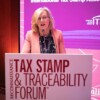
Interview with an ITSA Member – Authentix
13 Jun 2023 | Interviews
This month, we continue our series of interviews with members of the International Tax Stamp Association (ITSA), who share their experiences of the tax stamp industry and look ahead to some of the challenges and opportunities yet to come.

We began the series in the February issue, talking to Gerben van Wijk of Luminescence Sun Chemical Security, who is also Chairman of ITSA. We followed this up with an interview with two members of the high- security printing company Garsu Pasaulis.
Our third interview is with Tim Driscoll, Chief Technology Officer for Authentix. Tim has made a career in authentication, working alongside central banks, revenue agencies and industry partners to design and implement authentication, fiscal marking and production monitoring solutions across a diverse range of products and industries.
One key element of his responsibilities has been developing and deploying digital tax stamp solutions to fight tax evasion, and he recently sat down with Tax Stamp & Traceability News™ to share his experiences in this field.
Q: Please would you introduce your company?
A: As the authority in authentication solutions, Authentix focuses on bringing enhanced visibility and traceability to the global supply chain to help fight illicit trade across a range of industries. Our clients include governments for national fuel integrity and excise tax recovery programmes, central banks, and brand owners.
Our approach is to provide a complete, technology-based solution, configured with all the necessary elements to address the particular needs of each client. While our programmes use a diverse array of technologies to solve very different types of illicit trade, they’re unified in that they are all designed to generate actionable insights to help our clients succeed.
Q: What makes your company stand out?
A: We play the role of trusted partner to clients. It’s very important to understand the challenges a client is facing and be ready to adapt over time to any changes that occur in the business model or supply chain. It takes flexibility and keen awareness to work with a client, communicate effectively, share observations, and understand how to reach a successful outcome. Through our proven partnership model and sector expertise, our clients receive custom solution designs, rapid implementation and complete programme management to ensure revenue protection and product safety.
Q: What role does your company play in the tax stamp industry?
A: We play several roles. We’re a fully integrated tax stamp solution provider, offering the custom design and printing of secure, digital tax stamps as well as TransAct™, our cloud-based information management system that tracks the journey of each digital tax stamp through the supply chain.
The system is also used for order management, production monitoring, registering entrance into the programmes and generating reports that help quantify the size of any problem occurring, or the variances – positive or negative – since the programme began. This can show us the successes of a programme and help identify areas we can strengthen to reduce the continued threats of illicit trade.
Alongside that work, we can also provide dozens of overt and covert secure features for tax stamps or offer only parts of these overall solutions to address very specific programme needs.
For example, we enabled the Greek government to serve as the ID issuer in the EU Tobacco Products Directive programme, from its launch and throughout its first few years of operation. While Authentix didn’t provide the actual tax stamps or security features, we were able to deliver a specific part of our solution to help meet their immediate needs.
Q: What do you think is the most interesting aspect of tax stamps and/or the industry?
A: I think the most interesting thing about the industry is its evolution, and the increasing diversity of areas in which tax stamps are being applied.
Presently, we’re working with the Pakistan government to help fight tax evasion on cement, sugar, and fertiliser products, in addition to tobacco. This is very different from the typical products that normally fall under these programmes in many other countries.
However, it makes perfect sense: there are many benefits to be gained from these programmes, and expanding to other areas that are at risk of illicit activity offers many opportunities for governments to enhance tax revenue collection and reduce illicit trade.
Q: What changes have you seen to the tax stamp industry during your time working in it?
A: It’s been interesting to see how the industry has become established, with a healthy range of companies providing comprehensive solutions.
Originally, going back a couple of decades, many companies that had authentication capabilities pursued this market as something separate from the ‘bread and butter’ of their main operations. Now, we see a clear focus from many organisations on tax stamps, which has led to a greater number of service providers, and that in turn leads to a positive environment of innovation. Along with that comes new approaches and technologies that weren’t even imagined 20 years ago.
Q: What changes do you envisage happening within the industry in future?
A: While I think there will always be a role for physical tax stamps to be used as a marking method for some product categories, I can also see how other marking approaches – for example, direct printing and secure barcodes – can be the right answer in other situations. We’re keeping an eye on ways to make both of those more secure and robust, and more accessible, so they can be used not just by inspectors, but also by shopkeepers and the general public.
I envisage continued growth in direct digital programmes, with wider adoption. A particular area of innovation is likely to include the ways in which marking methods can provide robust track and trace, and improved security, all while being less invasive within production operations.
In the near term, technology for direct printing of barcodes, with an element that allows authentication, will become more mature. Ultimately, we’re looking to reduce interference in the day-to-day production operations for manufacturers of the goods affected.
At the moment, state of the art security requires a physical tax stamp, but I see possible paths to increasing the security level of direct printing, making that more applicable to higher value products in the future.
Q: What is one change to tax stamps or the industry you would like to see?
A: It would be really valuable to find a more effective way to communicate to revenue authorities that initiating
a tax stamp programme is a huge commitment. Even if they’re not paying for the programme directly (for example, if the industry is funding the project) these programmes are only successful when the solution and enforcement are both aligned.
A government or revenue agency new to tax stamps can see all the benefits, but they may not be well informed about how best to realise them. Coordination and funding of enforcement, for example, are key elements of a successful programme.
Of course, these require management support and resources, and if there isn’t a dedicated and prepared person or department ready to take on the responsibilities – for example, if the project is dropped on someone who already has full-time responsibilities – there’s a very good chance the programme will not meet the goals and objectives agreed upon until such focus and management is provided.
Q: What do you see as the main challenges within the industry today?
A: What I continue to be struck by is that the benefits from tax stamp programmes are virtually guaranteed. They’re almost always successful, which makes it particularly surprising and also frustrating that it remains a struggle to get programmes off the ground.
It’s near impossible to find a tax stamp programme that hasn’t had a positive return on investment, so why isn’t every country investing in them? However, while we do understand in some situations, there are groups that possibly benefit from illicit trade exerting pressure on authorities to deter them from the implementation of these programmes, it can still be frustrating.
Q: Why do you think the development of standards is important for the industry?
A: The main benefit of having standards is better support for governments when they’re making decisions regarding implementation of a digital tax stamp programme. Clear standards ensure that when a government is considering various solution providers, which may all take different approaches to tax stamp implementation, they have reassurance that they all follow specific guidelines and practices. That will enable well-informed decision making, so they can choose the best solution provider to meet their needs.







